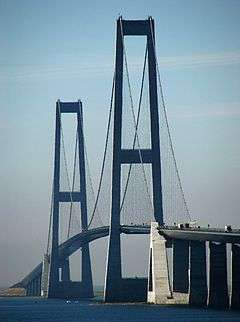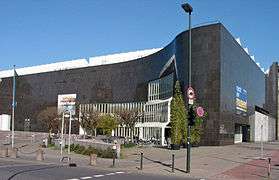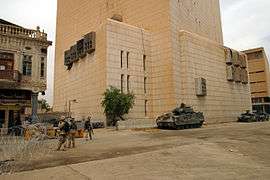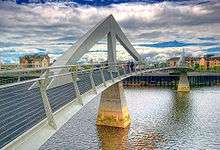Dissing+Weitling
Dissing+Weitling is an architecture and design practice in Copenhagen, Denmark. The founders and namesakes Hans Dissing and Otto Weitling founded the firm upon the death of Arne Jacobsen as a continuation of his office where both had been key employees.[1]
| Dissing+Weitling | |
|---|---|
 The Great Belt Bridge | |
| Practice information | |
| Key architects | Steen S. Trojaborg Poul Ove Jensen Daniel V. Hayden |
| Partners | Steen S. Trojaborg Daniel V. Hayden |
| Founded | 1971 |
| Location | Copenhagen |
| Significant works and honors | |
| Buildings | Danish National Bank DR Television Headquarter National Bank of Iraq |
Dissing+Weitling is particularly notable for the design of a great number of bridges around the world, ranging from small pedestrian and bicycle bridges to some of the longest bridges in the world, including the Danish Great Belt and Øresund Bridges.
History
Hans Dissing and Otto Weitling were key employees at Arne Jacobsen's office and they founded Dissing+Weitling in 1971 upon his death to continue and complete his unfinished projects. These included a city hall in Mainz, Germany, which has been extended also by Dissing+Weitling in 2008, a holiday resort on the north German island of Fehmarn, the Danish Embassy in London. In 1972, the firm won competitions for the IBM Centre in Hamburg and the Kunstsammlung Nordrhein-Westfalen in Düsseldorf, establishing the firm's name in its own right. Hans Dissing died in 1998 and Otto Weitling retired from the firm in 2002. Key architects and partners of the past were: Dieter Fremerey, Erik P. Handschuh, Poul Ove Jensen, Pouli H. Møller, Bodil A. Schaltz, Reinhard Schmidt-Petersen, Reinhard Tölke, Teit Weylandt, Stig Mikkelsen. Current partners are: Steen S. Trojaborg, Daniel V. Hayden.
Selected Projects
Buildings
 Mainz City Hall (1971)
Mainz City Hall (1971) K20 Art Gallery
K20 Art Gallery Central Bank of Iraq (1985)
Central Bank of Iraq (1985)
- Mainz City Hall (Rathaus), Mainz, Germany (completed 1971)
- Danish National Bank, Copenhagen, DK (completed 1971)
- IBM Centre, Hamburg, Germany (completed 1974)
- Castrop-Rauxel Forum & Town Hall (Forum & Rathaus), Castrop-Rauxel, Germany (completed 1976)
- Danish Embassy, London, UK (completed 1977)
- Central Bank of Iraq, Baghdad, Iraq (completed 1985)[2]
- K20 Art Gallery, Düsseldorf, Germany (completed 1986)
- Sonofon Headquarters, Copenhagen, Denmark (completed 1998)
- Parliament of Denmark renovation and interior design, Copenhagen, DK (completed 2004)
- Ny Carlsberg Glyptotek renovation, Copenhagen, Denmark
- DR Television Headquarter, Ørestad, Copenhagen, Denmark (completed 2006)
- Faculty Library, University of Copenhagen, Copenhagen, Denmark (completed 2008)
- Crowne Plaza, Copenhagen, Ørestad, Denmark (completed 2009)
- Rambøll Headquarters, Ørestad, Copenhagen, Denmark (completion 2010)
- Royal Golf Center, Ørestad (completion 2011)
- ECCO Hotel and conference building, Tønder, Denmark (completion 2012)
Bridges

- Great Belt Bridge, Funen/Zealand, DK (completed 1998)
- Mittellandkanal Bridges, Hannover, Germany (completed 1999)
- Øresund Bridge, Denmark/Sweden (Competition winner. The project completed in 2000 is not their winning design scheme)
- Nelson Mandela Bridge, Johannesburg, South Africa (completed 2003)
- University Bridge, Malmö, Sweden (completed 2004)
- Bryggebroen, Copenhagen, DK (completed 2006)
- Munksjön Bridge, Jönköping, Sweden (completed 2007)
- Stonecutter's Bridge, Hong Kong (Competition winner. Detail design by Arup. Completed in 2009)
- Åbroen, Copenhagen, DK (completed 2008)
- Tradeston Bridge, Glasgow, Scotland (completed 2009)
- ADNEC Bridge, Abu Dabi, UAE
- Sitra Interchange, Sitra, Bahrain
- Pirbrua over Nidelva, Trondheim, Norway
- Constantine Bridge, Wilaya de Constantine, Algeria (inaugurated on 05.07.2014)
- Osman Gazi Bridge in Turkey, a 2,682 m (8,799 ft) long road bridge with 1,550 m (5,090 ft) longest span[3] (completion 2010-2017).
- Queensferry Crossing, Scotland (completed 2017)[1]
- Under construction
- Botniabanen Bridges, Nyeland-Umeå, Sweden
- Qatar-Lusail bridge, Lusail, Qatar (competition win 2007)[4]
- New Gerald Desmond Bridge, California, USA (planned completion 2018)
- Competitions won
- Neue Alte Nahebrücke, Bad Kreuznach, Germany (competition won 2010)[5] The bridge was not built. Due to financial constraints the existing bridge 1956 bridge was restored.[6][7]
Awards
- 1999 Nykredit Architecture Prize
- 2015 WAN Transport Award for The Bicycle Snake[8]
References
- "Dissing + Weitling Architects, Denmark". e-architect. Retrieved 2009-07-20.
- "Central Bank of Iraq". Archnet. Archived from the original on 2010-06-19. Retrieved 2010-06-13.
- "Izmit Bay bridge". Dissing+Weitling architecture. Archived from the original on 2013-10-02. Retrieved 2013-03-31.
- "Cowi og Dissing+Weitling i norsk samarbejde". Building Supply. Retrieved 2009-07-20.
- Bad Kreuznach Bridge on Dissing+Weitling website. Retrieved 24 June 2018
- Historie – Die Alte Nahebrücke, 29 April 2015, in Kreuznachernachrichten.de. Retrieved 24 June 2018
- Gierse, Thomas (19 October 2015) Die Alte Nahebrücke steht auf neuen Beinen in hanz-online.de. Retrieved 24 June 2018
- "Simple. Elegant. Joyous". World Architecture News (in Danish). Retrieved 13 March 2015.
External links
| Wikimedia Commons has media related to Dissing and Weitling. |